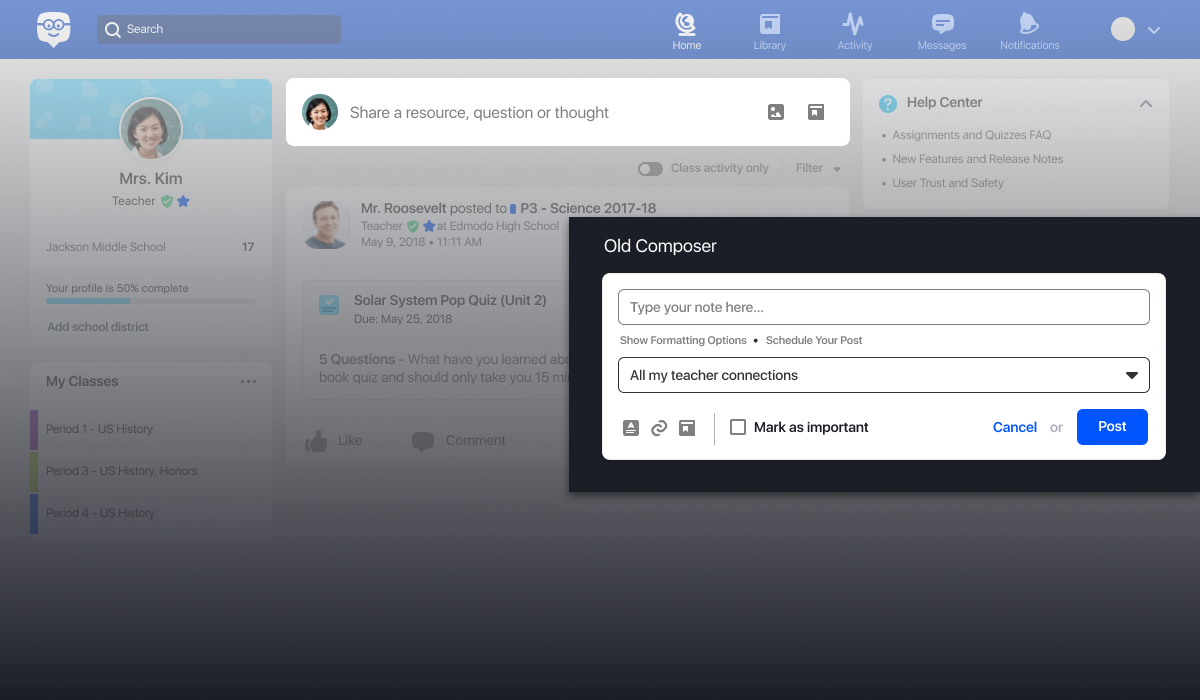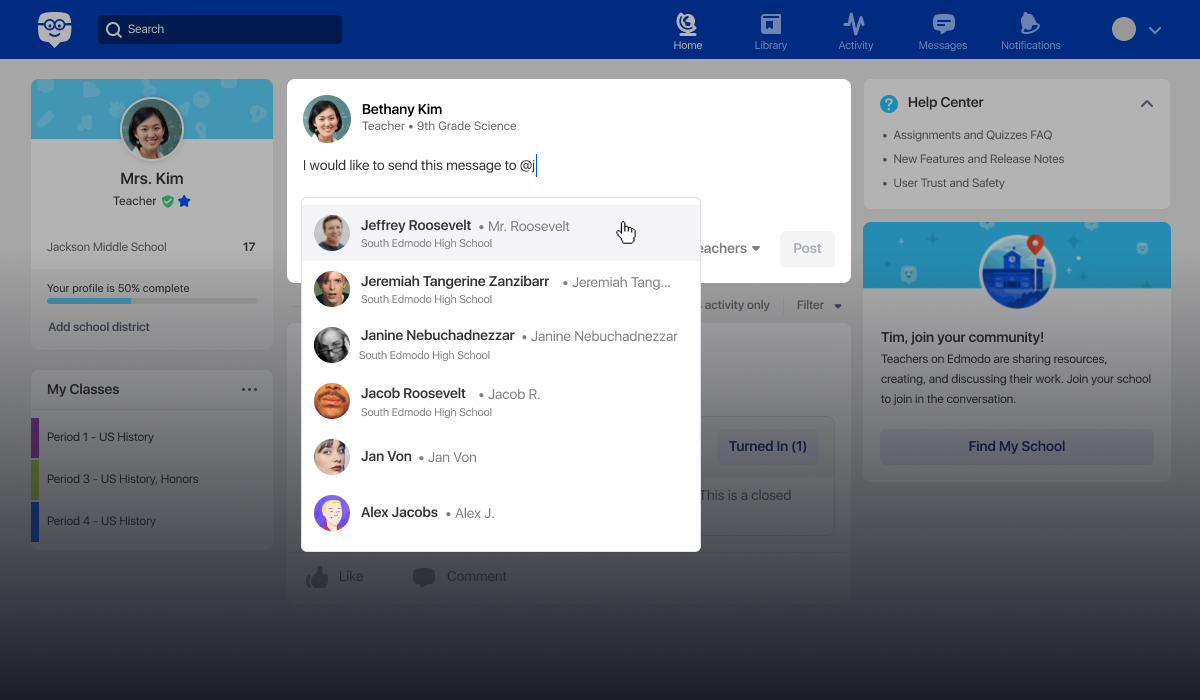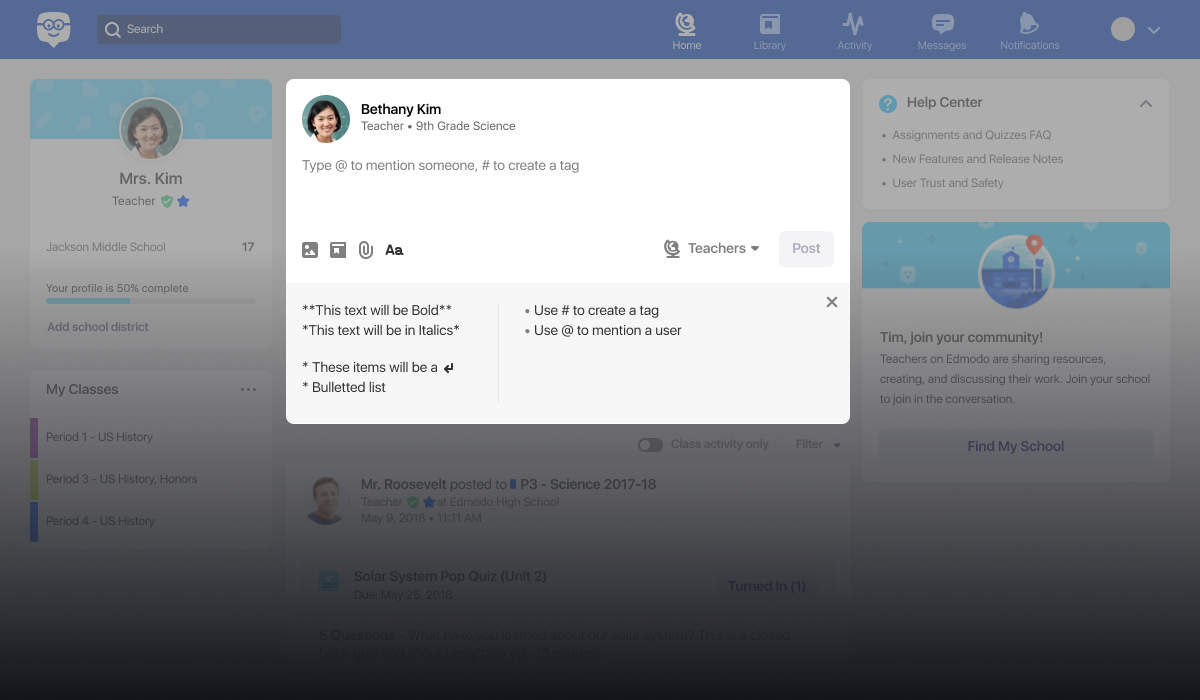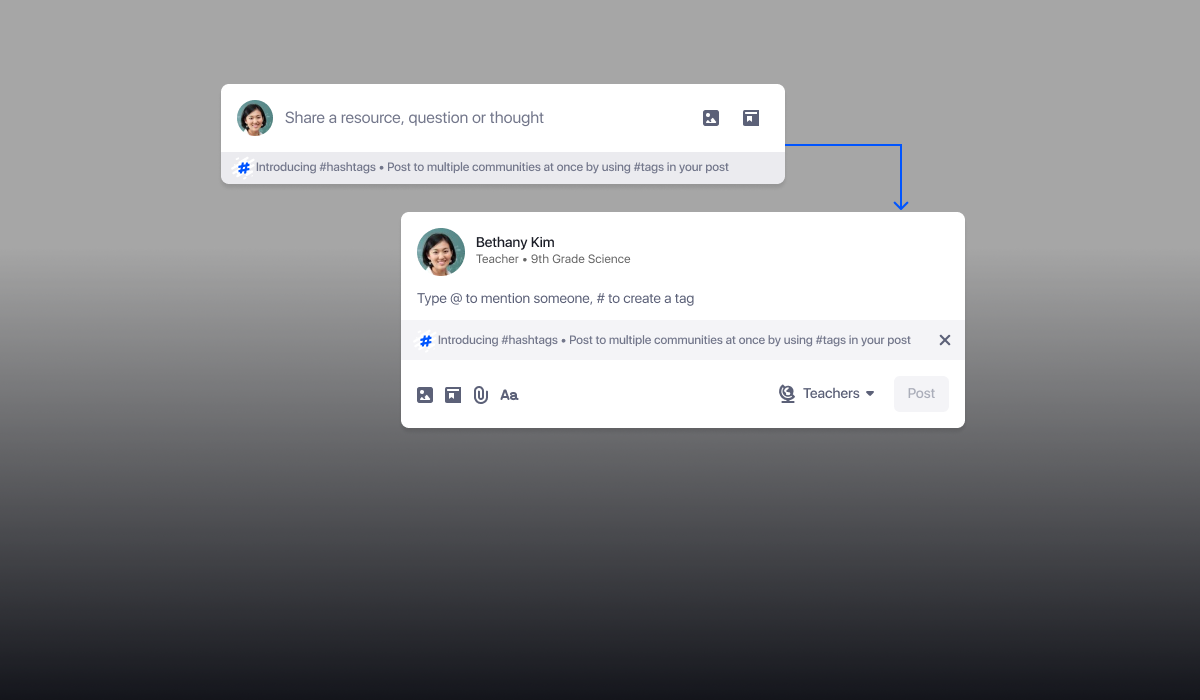EDMODO TEACHER NETWORK
While Edmodo is the home to the world’s largest learning network, there’s always room for improvement. In 2018, I, along with a PM, was tasked with assessing the health of and increasing the growth of our teacher network.
Goal
Increase the Daily Active Users (DAU) of Teacher Community features.
Research
We discovered that any given teacher’s connections were likely limited to their immediate geographic location and more likely school. Upon conducting various methods of research, it became obvious that teachers found the idea of connecting with other educators far outside of their personal network very favorable, but difficult to do. Furthermore, we found that teachers that had already expanded their connections beyond their respective schools had done so by meeting individuals in person, and then maintaining the relationship through Edmodo.
These relationships were easy to forge in person, but difficult digitally because of a vetting process that was taking place socially. When a teacher makes a professional connection with another teacher, that connection is primarily based on a shared experience level or expertise. New elementary school teachers connect with other new elementary school teachers, middle school algebra teachers connect with other middle school algebra teachers, etc. That shared expertise can then be leveraged in one’s own classroom or career as a resource. These types of assessments were almost effortless to make in person, but difficult to make digitally.
Also, when venturing outside of their school environment, teachers were almost always driven by a single topic. Technology and science teachers may attend a STEM convention and meet other teachers interested in STEM education, Early childhood ESL teachers may attend a regional language educators conference and meet other teachers passionate about language education, etc. There was no such mechanism serving as a forcing function to gather around on Edmodo. Teachers simply had to vet, research, and contact strangers on the platform if they were interested in creating a new connection outside of their real-life network.
First-time teacher Empathy Mapping
Other research takeaways:
Teaching materials shared on our platform took too much effort to review and vet.
Sharing with other teachers on the platform was seen as stressful.
Teachers were highly unlikely to repeatedly post publicly if a previous public post received no engagement.
21% of public posts contained a “?”
These posts were 43% more likely to receive some form of engagement.
Problem
Teachers on Edmodo find it difficult to find and form connections with other teachers that have relevant interests and experiences.
Behaviors
Our first step towards visualizing our improved teacher network was to put together an understanding of how teachers were already using other social platforms. In our interviews with teachers, four platforms were constantly mentioned: Facebook, Twitter, Pinterest and Teachers Pay Teachers.
Teachers using Facebook reported using Facebook groups primarily to find resources related to their taught subject. Members of these groups would vet the quality of resources by scanning the conversation in the post replies attached to the original post containing the resource. Members would also further vet posted resources by poking about the poster’s profile and checking out their work and post history.
Teachers reported that they were not very likely to post their own resources in these groups. The social and professional pressure to post something immaculate in such a public space was a big source of anxiety.
Teachers reported using Pinterest for classroom inspiration. Fun ideas could be browsed in an easy to consume visual stream and organized into meaningful groups for later use.
We surprisingly found that Twitter is very popular with teachers. Teacher’s use of Twitter differentiated itself from that of Facebook in that Twitter facilitated the participation in conversations on very specific topics and events. These topics and events were always temporally relevant and Twitter was seen as the best way to stay up to date with the conversation, whatever it may be.
Teachers Pay Teachers
Teachers Pay Teachers is a platform that allows teachers to publish their own resources for profit. It was exceedingly rare to find a teacher that had published materials on TPT, but almost all teachers reported having used TPT to find resources. Resources on TPT far and away were reported as being of much higher quality than any other social media platform. Finding and filtering for specific resources was also easiest on TPT.
Personas
Based on the knowledge we had of teachers’ behaviors and motivations on our own platform and our knowledge of teachers’ behaviors on other platforms, we formed four personas to help us empathize with our different users’ needs:
The Newbie
Feelings: Anxious, Excited, Optimistic
Network Behaviors: Talks to every other teacher within their grade at their school on the platform. Actively uses social media to find support for new teachers. Because they are starting from scratch, is willing to pour time into vetting new and unknown resources in hopes they will pan out. Tends to be active on or familiar with social media and Is willing to create content or ask questions publicly without much anxiety.
Network Goals: Wants to find enough support and resources to establish themselves and feel secure. Wants to find more experienced teachers that they can learn from.
The Browser
Feelings: Relaxed, Curious
Network Behaviors: Is interested consuming a high level feed of news, ideas and conversations regarding teaching. Already uses social media and mostly scrolls through their feed during downtime. Will give a like, heart or upvote, but is very unlikely to post anything. The user the “infinite scroll” was invented for.
Network Goals: Wants to be informed about what conversations are happening on their topics of interest.
The AMBASSADOR
Feelings: Determined, Isolated
Network Behaviors: The Ambassador likely is the sole teacher of their subject/grade at their school. They actively search for and engage heavily with social groups that focus on their teaching subject. They frequently lead collaborative efforts within these groups and share their own materials and perspectives.
Network Goals: To create a support network for themselves and teachers like them.
The MENTOR
Feelings: Confident, Established, Secure
Network Behaviors: Takes pride in posting their own resources or other resources they find useful. Likely to post open-ended questions or requests with objective of starting a conversation. Likely to be the admin of a social media group related to their professional expertise.
Network Goals: To be visible and respected within their online communities.
Hypothesis
Teachers are more likely to post and engage with content if they feel that their feed is relevant to them. Those posts and engagement will lead to more meaningful connections, and ultimately, more retention and daily active use.
The Social Ecosystem
Bringing teachers together on a social platform was not going to be any small feat. We identified three key feature areas that had to be improved to address our findings: Posting, Relationships and Content.
Posting
private messages → public stream
Originally, from the home page, users could send direct messages to their connections, and their schools. Posting publicly was done essentially through message boards accessible only from a small module a pretty far scroll down the home page. If a larger, more engaged teaching community was what we were after, it was obvious we would need to pull public posts from the neglected nook it languished in to the forefront of the social stream. From our research, we knew that the overwhelming majority of teachers were familiar with the standard social media composer, and understood that posts composed there were not treated as direct messages, but were just view-able by friends/followers, with the default being public. We had also relatively recently build a direct messaging feature that allowed for private messaging, essentially making the functionality of the old social stream composer obsolete. Thus began the work to move away from a private message composer model, to a public post model.


Posting anxiety
Before teachers would be comfortable posting publicly, a few concerns had to be addressed. Teachers had reported feeling a bit of anxiety when posting using our old composer and other social media composers. These concerns were mainly:
Is my identity visible? Does it represent me well?
What will my post look like?
Did my attachments upload correctly?
Who can see my post?
POSTING DESIGNS












Relationships
TeachING Profile
As we already knew, teachers preferred to connect with other teachers that shared their general geographic location, taught subject and taught age group. The problem was that we were not collecting that information in any meaningful way. Before we could begin grouping similar teachers together, we had to collect the information that would allow us to do so.
One of the biggest issues was how we were organizing the data. Teachers could input any number of subjects they had taught or were teaching with no differentiation between the two. Also, teachers could input the age group (by grade) or groups of their past and present students, but had no option to tie the age group to the subject. Teachers that selected a range of age groups were only able to select the options on a slider input, and the beginning point, end point and all points in between were stored. I know this is hard to follow, so here’s an example of how this collection method was failing us.
A teacher who in the past has taught fourth grade (all subjects), but currently teaches seventh grade English would be stored as follows: 4th,5th,6th, and 7th grade teacher of English, All Subjects.
Stored this way, there’s absolutely no way of knowing what is important to this teacher. Do they teach 6th grade All Subjects? 5th Grade English? What type of content is relevant to them? What kind of other teachers can they be matched with? Absolutely impossible to tell. To fix this problem, we had to come up with a smarter way of organizing the data and recollect it from our users.
Collecting this at sign up made the most contextual sense, but it would not include existing teachers. Additional entry points had to be created and, more importantly, immediate value had to be provided to teachers that opted into giving us this info.
TEACHING PROFILE DESIGNS
Please note that we went though a redesign and a rebrand in the middle of these designs, so from here on out, designs showcased will be quite stylistically different.









Connections →Following
Speaking of connections and connecting, this was an action that had a lot of anxiety surrounding it. Sending a request to a potential stranger and then that person accepting a request from a likely stranger was seen as far too intimate a maneuver for the desired outcome. Even worse, becoming a ‘Connection’ to another teacher provided absolutely no benefit other than the ability to privately message them. We decided that a different relationship model for teachers on the platform would better satisfy their needs and ours. We decided that our two-way request/approval Connection relationship would be replaced with a less committal Follower/Followee model. The goal, after all, was to create a rich and open ecosystem of content, where relationships began with content and progressed from there.
Content
hashtags
Hashtags are already a great way of mapping conversations and providing some sort of topical social signal around them on other social media platforms, so it made sense to use a similar system on Edmodo. Hashtags allowed teachers to effortlessly view and participate in popular conversations that were happening in real time. Also, once we captured the teacher profile info mentioned in the section above, it allowed us to begin recommending hashtags to follow that were tailored to the teacher’s interests. With topical conversations and conversations that were related to a teacher’s specific interests, the stream began to feel like a living, customizable experience.
We’ve already seen quite a bit of the new designs around hashtag features, but below are the rest of them.
HASHTAG DESIGNS





End of phase 1
This might seem like a lot of things, but these changes are just the first phase of a huge number of features and adjustments aimed at changing (for the better) how teacher’s share and connect with each other.
OUTCOMES - So far
The rudimentary changes to our social network structure were all launched at various times in 2019. Finer features are still being rolled out.
As a seasonal business, education products like Edmodo see heavy adoption and usage around the back to school season. At the time of writing this, we’re only two months into the back to school season, so we have two months worth of year on year data to be looking at. So far, without getting into specific numbers that could get me in trouble, the creation of public posts is up ~400-500% and engagement on public posts is up ~300%. Also, the percentage of our user-base using the public post feature is trending upwards, out of the gate accomplishing our original goal of converting non-community users to actively engaged ones. It’s a bit too early to see if any of this translates to retention or any other longer term numbers however. Overall though, off to a pretty promising start.




















